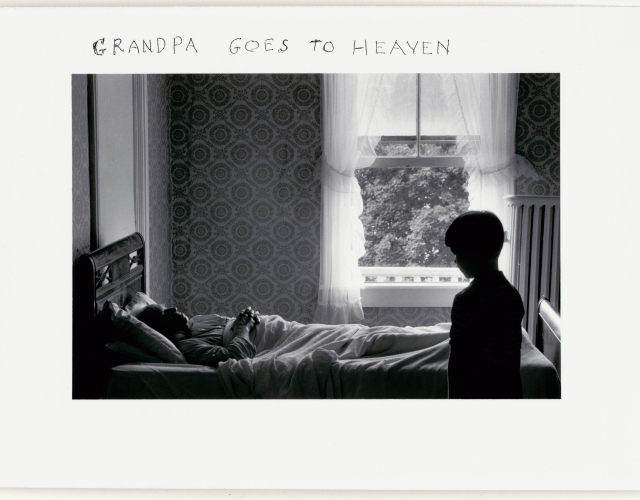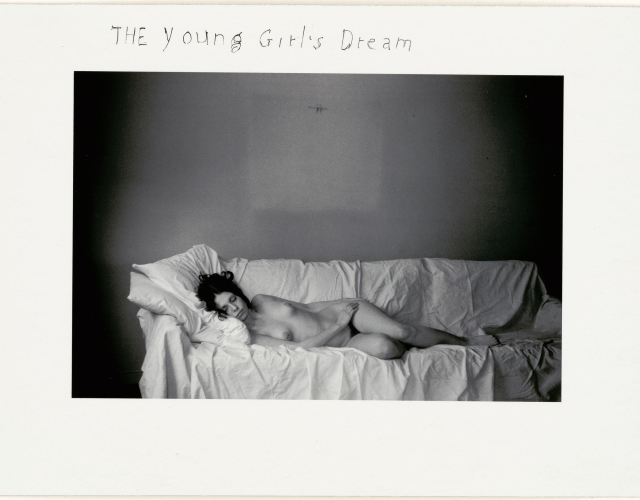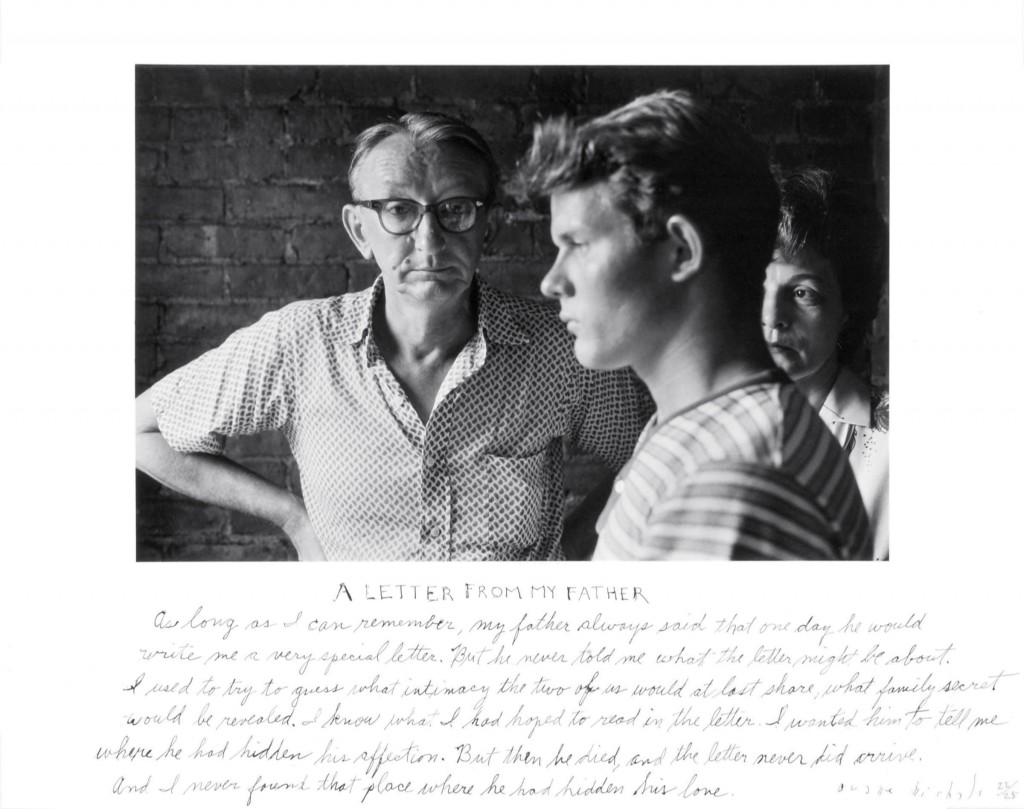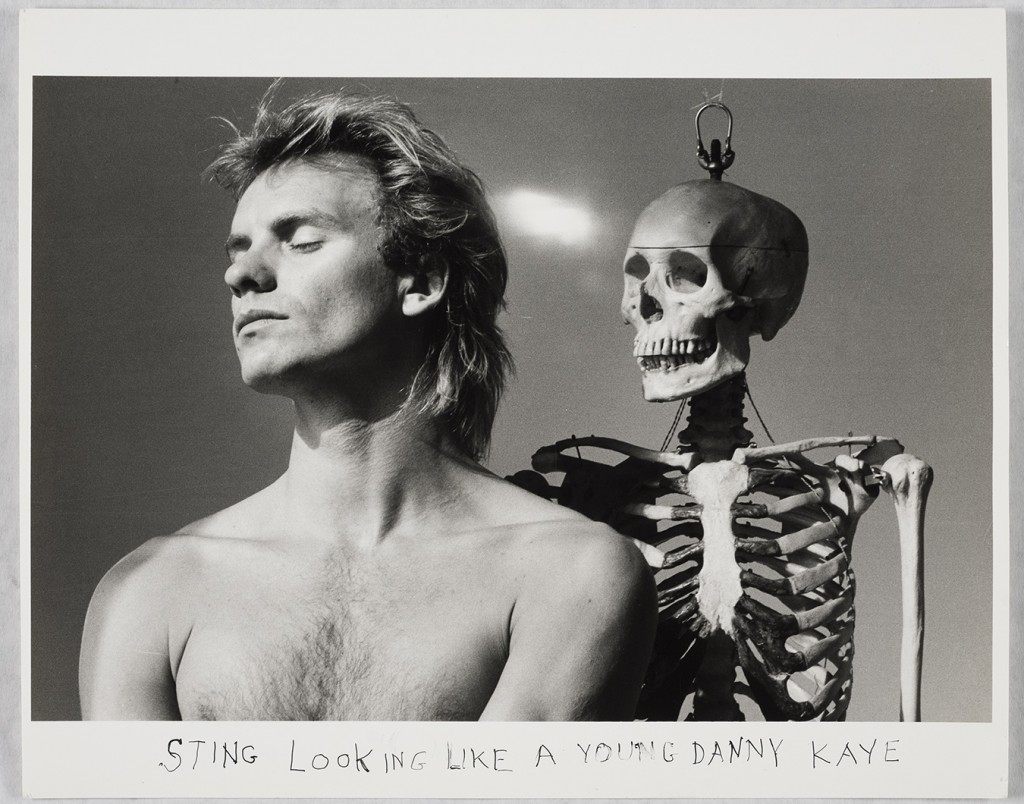Duane Michals: Adventures in Black and White Magic
Are there alternate worlds, perhaps made of anti-matter? We don’t know. We do know that in one strange world, there lives an artist whose hometown roots are strikingly similar to those of a certain other artist, Andy Warhol.
Duane Michals, like Warhol, was born over 80 years ago to parents who had immigrated to the Pittsburgh area from present-day Slovakia. Both men grew up in blue-collar neighborhoods—in Michals’ case, McKeesport—and both launched their careers in New York, where they became known as radical innovators.
Along the way they crossed paths, and met cordially, but they weren’t orbiting the same circles. Michals’ art, his artistic vision, and the personality he projects turned out quite differently. In those respects, he’s the Anti-Warhol.

As Michals demonstrated in this selfie from 1972, you can take the boy out of McKeesport, but you can’t take the McKeesport out of the boy.
Michals’ world is on display through Feb. 16 at the Carnegie Museum of Art in a major exhibit called Storyteller: The Photographs of Duane Michals. To sum it up with a four-letter word, the show is a trip. Prepare to be transported. Not, however, in the manner of your typical knock-‘em-dead art show.
Storyteller doesn’t blitz you with big, splashy, colorful pieces in multiple media. Michals is a photographer, and while he takes the medium to places others haven’t, he has worked mostly in black-and-white, and prints most of his images no larger than the standard 8×10 inches (with many only 5×7).
Throughout the long and spacious galleries are hundreds of Michals’ quarky photos—small, but packed with substance and energy, like quarks. In tones that range from the obscenely humorous to the profound, the photos explore such subjects as sex and death, dreams and memory, youth and age, celebrities like Robin Williams and Meryl Streep, and the cosmic experience of meeting God in the New York subway.
What is most remarkable about Michals is how he treats his subject matter. Now 82 years old and still kickin’, Michals has often said he tries to photograph what can’t actually be seen in everyday reality. (“Real, to me, is a relative word,” he once told an interviewer.)
The exhibit presents his lifelong attempts to get at the shimmering space between the seen and the unseen, in the time between what has just happened and what could possibly happen—which, of course, is where we always live.
The Art of the ‘Sequence’
One way Michals goes about his tricky business is by stringing together a sequence of photos, like panels in a comic strip, to tell a story. (Thus the title of the exhibit.) Here is one of his most popular sequences, “Grandpa Goes to Heaven”:
Clicking through, you can see right away that it’s both a magical story and one that nearly anybody can relate to. A closer look reveals some elements of Michals’ artistic approach.
The opening scene of Grandpa ill in bed is rendered realistically, with things in crisp focus and a natural-looking balance of dark and light areas. Then in the next three frames, a basic photographer’s trick creates a supernatural aura. Overexposing the photos lets the backlight from the window become a surreal blaze of light that “blows out” some details and blurs edges.
But Michals stops short of making Grandpa’s transformation totally awesome. In Frame 2, we (and, presumably, the boy) see the fake, child-sized angel wings strapped to his back, the kind kids wear for Halloween. This blatant stunt adds subtle wrinkles to the tenor of the story, giving it a child-friendly bit of humor … plus a note of uncertainty. Children wonder whether the things adults tell them about death are true: Is the departed really “in a better place” or is that a fairy tale, something made up, like these wings?
If Grandpa had a more convincing angel costume—and was made to ascend or vanish majestically, instead of hunching out the window in his rumpled PJs—it’d be a conventional story, literally illustrating a set of conventions. What’s done here is finer. Amid the ambiguity, there’s an unmistakable grace note—Grandpa’s smiling good-bye wave is pure love—and in the end, the boy is left wondering and searching. As we are.
Pictures that Speak, Words that Illustrate
The Storyteller exhibit has many more photographs, either grouped in sets or standing solo, made with other tricks that Michals has up his sleeves. Below is a very simple one, in an erotic sequence called “The Young Girl’s Dream.”
No need for much commentary. The ghostly dream-figure of the young man is double-exposed. And the punch line, in the final frame, is that little touch.
The moral might be that a picture is worth a thousand words—except Michals uses words to great effect as well. He writes long, storytelling captions in the margins of some photos, and one of the stand-alone photos has a caption that’s particularly haunting. The picture is a smiling young couple with the girl playfully hugging the guy. Underneath is written:
“This photograph is my proof. This photograph is my proof. There was that afternoon, when things were still good between us, and she embraced me, and we were happy. It did happen, she did love me. Look see for yourself!”
Those 40 words do more than tell a story; they convey, in a nutshell, the infinitely ironic implications of a life lived through pictures of it.
Conversely, some photos in the exhibit are so strong that captions seem unnecessary. One example is a family portrait taken in 1960, and later titled “A Letter from My Father.” This is the photographer’s brother Tim being eyed by his (and Duane’s) parents:
The caption was added in 1975, after the father died. It refers to a letter Dad had promised to write Duane but never did—which makes for a moving story. But, my goodness, behold the photo. I have not seen a more concise portrayal of how youth feel under the stern, expectant, demanding, and disappointed eyes of their elders.
Memes from the Beyond
Many of Michals’ photographs have classical undertones. “A Letter from My Father” is one of several that conjure up visual echoes of paintings by the Renaissance master Andrea Mantegna. His paintings feature people with intense expressions and geometrical compositions that lock in more power. Keeping the Michals family portrait in mind, link over for a moment to Mantegna’s Ecce Homo. It has the same sort of arrangement; it has that glare.
To tap another vein, try the photo below, “Sting Looking Like a Young Danny Kaye.”
While the picture can stand on its own merits, looking at it triggered an art-history synapse deep in my aesthetic nervous system. At home I searched “Frans Hals” on the web, and sure enough, up came a link to the Dutch painter’s Young Man with a Skull. Separated at birth? Nope, the pictures were made about 350 years apart.
In such cases it’s pointless to ask if Michals consciously emulates the old masters. Memes are not a recent invention; there are ways of seeing and expressing things that have persisted through the ages. We all “appropriate” them, consciously or otherwise, and what you can find in a number of pieces in the Storyteller exhibit is the work of an ingenious appropriator with a wicked sense of humor.
We all have seen canvas high-top basketball sneakers, such as the Converse Chuck Taylors. But you won’t see a giant sneaker of that type turned into a phallic object by a young man trying to ride it like a witch’s broomstick until you look at Michals’ photo sequence “Burlesque.” Just be warned that once you do, the images are liable to stick in your mind like an insane pop tune that won’t go away. Or, or …
I could go on indefinitely. In my notes from the exhibit, so many photos are flagged as outstanding that to mention them all would amount to writing a catalogue. See the show. It’s like an exotic restaurant with an all-you-can-eat buffet. You will find your own favorites, and then you may be collaring other people to say, “Wow, did you see ‘People Eat People’? Or ‘Certain Words Must Be Said’? Or …”
Duaneland: The Movie
Finally, allow time to watch at least part of Duaneland, a 64-minute documentary about Michals. Shot in the early 2000s when the artist was in his early 70s, the film is screened throughout each day in a viewing area within the exhibit. Many scenes capture the master appropriator behaving most inappropriately, as he is wont to do.
Invited to give a lecture at the Metropolitan Museum of Art in New York—before an audience of the city’s cultural elite—he opened by saying how nice it was to be so old that you don’t have to worry about what people think of you. “Watch this,” he said. “Fuck fuck fuck fuck fuck fuck!”
Other scenes show parts of Michals’ visit to his alma mater, McKeesport High School. There he spoke up-close and personally with a group of students who’d gathered to hear his words of wisdom. Seeing their astonishment when he frankly disclosed that he is gay—remember, this was more than a decade ago—he proceeded to, well, jag them about it. “Have you ever met a gay guy before? … Oh, where is he? Introduce me!”
Michals kept pushing things beyond the bounds of P.C. After a couple of jokes about his youthful days as a clumsy altar boy (“I was a falter boy”), he cracked one about a parish priest who, he said, “claims that I molested him.”
You have to cringe. And yet, as this kind of stuff continues, one sees what Michals is up to. He’s poking at, and trying to break down, stereotypical beliefs that the students may have about gay men: that they’re rabidly promiscuous, that they’re predatory, and so on.
Having grown up myself in a blue-collar town near McKeesport, I would risk another stereotype by observing that Michals’ way of relating to people is common in such neighborhoods. One learns that a well-rounded individual must have a joke or wisecrack for any occasion, and must keep ‘em coming relentlessly. They’re the theme music of life.
Moreover, one learns that a gentleman must have a good heart behind his sharp tongue, and Michals appears to have that. The film also shows him urging the young folks at the school to think bigger about what they’re capable of achieving in life.
Michals: The Man
And, in person, he seems a very nice guy. On the exhibit’s opening day, I found the great man in the museum lobby, seated at a table by the gift shop. Dapper in a dark sweater and scarf, he was signing books of his photography. There was a line. The books kept coming. Ever the joker, Michals was lifting his forearms and pivoting mechanically, like a robot, to take and sign each one. Yet he signed graciously, asking if he should write a personal message above the autograph.
At a brief lull I stepped in, requesting permission for a single interview question. I said: Duane, if you could give people just one reason to come and see your show, what would it be—what’s the advertising slogan, the value proposition?
Grinning, he fired back, “Liquor is quicker but Duane is better.” Then he really got into it, trying to top the cliché. “No, no—wait—how about this: ‘Call when you have work.’” He has long earned money as a commercial photographer, which is where that line came from. Politely I noted that it didn’t offer a direct benefit, and thus wasn’t a value proposition.
People were waiting again. So he said: “Well, I’ll give you a preposition. ‘To.’ That’s the preposition. The preposition of this show is ‘to’.”
Closing Credits and Viewer Info
Storyteller: The Photographs of Duane Michals has been organized by Linda Benedict-Jones, curator of photography at Carnegie Museum of Art. The documentary Duaneland (2004) is by Pittsburgh filmmakers Stephen Seliy and Joseph Seamans; two short films are shown along with it at the exhibit.
When visiting the Museum’s Heinz Galleries for Storyteller, you can enhance the trip by stepping over to Gallery One, which has a selection of works by other artists from Duane Michals’ personal collection. The museum also has scheduled various special events related to Michals and his art. Through Feb. 16, 2015. 4400 Forbes Ave., Oakland.
All images of Duane Michals’ photos are courtesy of the artist and DC Moore Gallery.
Mike Vargo, a Pittsburgh-based writer and editor, writes about the visual arts and theater for Entertainment Central.
Share on Social Media
Follow Entertainment Central
Latest Stories
Sign up for the EC Newsletter












